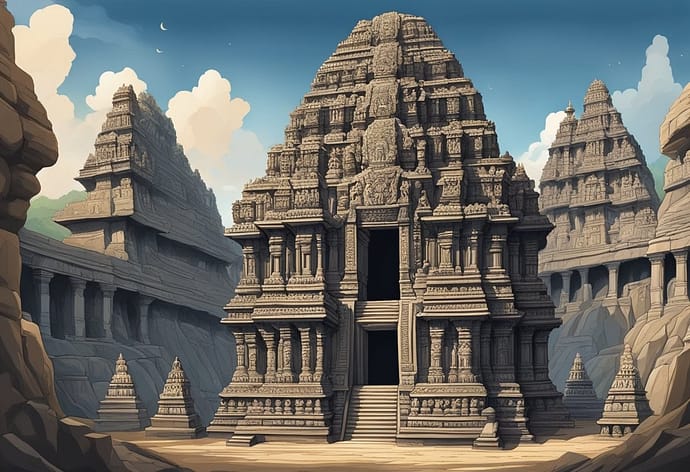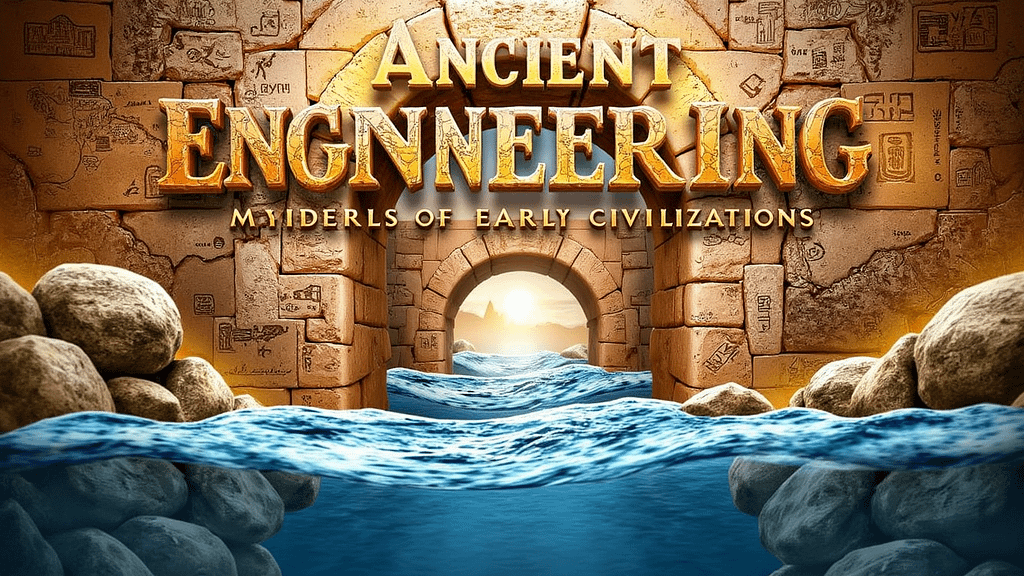The Kailasa Temple stands as a remarkable feat of ancient architecture and spirituality. This iconic rock-cut temple, carved from a single monolithic rock, showcases the extraordinary craftsmanship of the Rashtrakuta Dynasty and remains a significant symbol of India’s rich cultural heritage. Although many aspects of its construction and purpose remain shrouded in mystery, the temple’s grandeur continues to captivate historians, archaeologists, and visitors alike.
As one of the most significant monolithic structures in the world, the Kailasa Temple offers a unique glimpse into the religious practices and artistic expressions of its time. Its intricate carvings and elaborate design not only reflect the creative skill of its creators but also highlight the spiritual beliefs prevalent during its construction. The temple has become a subject of fascination for those seeking to understand the complexities of ancient Indian civilisation.
Exploring the mysteries of the Kailasa Temple leads to a deeper appreciation of its historical and cultural significance. Exploring its architecture and the stories it tells can offer valuable insights into the past while continuing to inspire future generations.
Key Takeaways
- The Kailasa Temple is a masterpiece of ancient rock-cut architecture.
- Its intricate design reveals the religious and cultural values of its time.
- The temple remains a vital part of India’s historical and spiritual landscape.
Historical Context
The Kailasa Temple, situated in Ellora, India, embodies a distinctive blend of artistry and religious significance. Its construction, patronage, and architectural details offer insight into its historical context and its importance in Hindu worship.
Patronage and Construction
The Kailasa Temple was commissioned during the reign of King Krishna I of the Rashtrakuta dynasty in the 8th century. This period marked a significant flourish in temple architecture in southern India. The king sought to build a grand structure in honour of Lord Shiva.
Construction began in 756 CE and was completed over several years. Skilled artisans and workers undertook this monumental task, carving the temple directly from the rock. This technique required immense planning and expertise, reflecting the ambitious vision of the king.
Architectural Significance
The Kailasa Temple is renowned for its distinctive architectural style, which embodies the Dravidian architecture of the period. It stands as a remarkable example of rock-cut architecture, where the entire structure is a single, monolithic entity carved out of a single rock.
Key features include:
- Mandapa: The entrance hall leading to the main shrine.
- Shikhara: The towering spire above the sanctum.
- Intricate carvings: Scenes from Hindu mythology adorn many surfaces.
These elements not only highlight artistic skill but also underscore the temple’s significance as a site for worship and pilgrimage.
Chronology and Dating
Dating the Kailasa Temple accurately presents some challenges due to the limited historical records available. Scholars generally agree on a construction date in the late 8th century.
Most studies employ art historical and architectural analysis in conjunction with inscriptions found in nearby caves. The temple is often linked to other significant constructions from the Rashtrakuta period, which helps establish a broader timeline of its development and influence in the region.
In summary, the Kailasa Temple is not just an architectural marvel; it is a testament to the rich history, artistic prowess, and religious devotion of its time.
Archaeological Overview
The Kailasa Temple, a remarkable feat of engineering and artistry, showcases unique excavation techniques and impressive rock-cut architecture. This section dives into the methods used to uncover its secrets, the intricacies of its design, and the layout of its structures.
Excavation Techniques
The Kailasa Temple was carved directly from solid rock, which makes its archaeological significance immense. Excavation at this site involves meticulous planning and careful analysis to preserve its delicate details.
Archaeologists employ both traditional and modern techniques, including:
- Surveying: Detailed measurements help understand the temple’s layout.
- Drones: These assist in aerial photography for mapping.
- Ground Penetrating Radar (GPR): This technology enables the discovery of hidden features without disturbing the site.
Each technique reveals layers of history and construction methods used by ancient artisans.
Rock-Cut Architecture
Rock-cut architecture is exemplified by the Kailasa Temple, making it one of the most significant monolithic structures in the world. Carved from a single rock, this temple showcases extraordinary craftsmanship.
Key features include:
- Intricate Sculptures: The walls are adorned with intricate carvings that depict various deities and mythological stories.
- Open-air courtyards: These areas create transitional spaces between various sections of the temple.
- Vertical and Horizontal Elements: The combination of pillars, beams, and architraves demonstrates an advanced understanding of structural engineering.
This architecture reflects the ingenuity of its builders and their deep religious devotion.
Layout and Structures
The layout of the Kailasa Temple is both complex and intentional, designed to facilitate worship and meditation. The temple features a central shrine dedicated to Lord Shiva, surrounded by various halls and niches.
Noteworthy structures include:
- Main Sanctum: Houses the Shiva Linga, a symbol of divine energy.
- Side Shrines: Dedicated to other deities, these shrines demonstrate the temple’s inclusivity in worship.
- Pillared Halls: Provide space for congregational gatherings and rituals.
Each element is strategically positioned, creating a harmonious flow for worshipers and enhancing the spiritual experience.
Religious Significance
The Kailasa Temple holds profound religious significance in Hinduism and draws numerous pilgrims. It embodies rich mythology and serves as a key pilgrimage site for various faiths. This temple reflects a complex set of beliefs and traditions that have evolved over centuries.
Hindu Mythology Depictions
In Hindu mythology, Mount Kailasa is revered as the abode of Lord Shiva. It is often depicted as a sacred mountain where divine events unfold. Myths claim that it is the centre of the universe, connecting heaven and earth.
The Kailasa Temple itself represents this mythology in architectural form. Carvings and sculptures inside the temple showcase legends and stories related to Shiva and Parvati. These depictions offer insight into the spiritual realm and the importance of devotion.
Pilgrimage Site
Kailasa Temple is a significant pilgrimage site for Hindus and followers of other religions. Pilgrims travel from far and wide to seek blessings and perform rituals. This temple is not just a structure; it symbolises spiritual aspirations and divine connection.
During festivals, the temple becomes a hub of activity. Thousands gather to honour Shiva through prayers and celebrations. The sacred geography of the area enhances its importance, making it a key destination for spiritual seekers.
Artistic Features
The Kailasa Temple is renowned for its remarkable artistic features that showcase the creativity and skill of ancient artisans. These elements highlight its significance in Indian art and architecture.
Sculptures and Carvings
The temple boasts an impressive array of sculptures and carvings. Intricate reliefs depict scenes from Hindu mythology, particularly stories related to Lord Shiva.
The main structure features a majestic representation of the Trimurti, showcasing Shiva, Vishnu, and Brahma. Each figure captures unique expressions and details that bring the narratives to life.
Additionally, countless more miniature sculptures line the temple walls, reflecting everyday life in ancient India. Artisans used basalt rock, masterfully chiselling these detailed artworks, which remain intact despite years of weathering.
Intricate Design Elements
The Kailasa Temple is also renowned for its intricate design elements, which embody the exceptional craftsmanship of the era.
Elaborate motifs, such as floral patterns and geometric designs, adorn various surfaces. These decorations are not merely aesthetic; they hold symbolic meanings related to spirituality and nature.
The temple’s grand entrance features beautifully carved pillars that highlight local craftsmanship. The use of rhythmic patterns guides visitors through the space, enhancing the overall experience.
Each design choice reflects the temple’s sacred purpose, inviting contemplation and reverence from all who visit.
Engineering Marvels
The Kailasa Temple is a remarkable example of ancient engineering. Its unique features illustrate the skill and creativity of the artisans who built it. Two key marvels include the single rock carving technique and the advanced drainage systems used.
Single Rock Carving
The Kailasa Temple is renowned for being a single rock carving. This means it was sculpted from one large basalt rock, a feat that showcases impressive engineering skills.
Artisans began at the top and worked their way down. They meticulously carved intricate details, including the temple’s pillars, sculptures, and deities.
This method required extraordinary planning and precision. Any error could have resulted in structural instability or the loss of valuable stone.
The artistry is seen in the beautiful reliefs and elaborate designs that adorn the walls. The craftsmanship reflects the dedication of the builders to their religious and artistic vision.
Drainage Systems
Another incredible feature of the Kailasa Temple is its advanced drainage system. The builders incorporated clever solutions for managing rainwater.
Channels carved into the rock direct water away from the temple, preventing erosion and damage. This system ensures the temple remains intact through various weather conditions.
Moreover, the design reflects an understanding of water management, highlighting the builders’ foresight. These drainage systems were crucial for maintaining the structural integrity of the temple over the centuries.
By integrating such practical features, the temple stands as a testament to the engineering expertise of its creators.
Conservation Efforts
Conservation efforts for the Kailasa Temple focus on addressing preservation challenges and implementing restoration projects. These initiatives aim to protect the temple’s unique architecture and rich cultural history.
Preservation Challenges
The Kailasa Temple faces significant preservation challenges. Environmental factors are a primary concern. Weathering and erosion from rain and wind threaten its intricate carvings and stonework. This temple is also vulnerable to human activity, such as littering by visitors. For instance, the Kora trail around Mount Kailash has been reported to contain plastic waste and other debris, which can have a lasting impact on the site’s integrity.
Limited funding and resources further complicate these efforts. Many local organisations lack financial support for necessary maintenance work. Preservationists are actively seeking partnerships with government and international bodies to secure funding.
Restoration Projects
Restoration projects are underway to address the challenges facing the Kailasa Temple. Local and international conservation groups are collaborating to develop plans for repair and maintenance. Efforts include cleaning stone surfaces, repairing structural damage, and restoring artwork.
A noteworthy project involves documenting the temple’s current condition. This information helps prioritise areas that need urgent attention. Specialised teams use non-invasive techniques to assess stone degradation. Additionally, educational programs aim to raise awareness among visitors about the importance of preservation.
These projects not only restore physical structures but also foster respect for the temple’s cultural significance. By engaging the community, these initiatives promote sustainable tourism practices that benefit both the site and residents.
Cultural Impact
The Kailasa Temple has had a profound impact on both Indian architecture and its global recognition. Its unique design and artistry have inspired numerous structures throughout India and beyond.
Influence on Indian Architecture
The Kailasa Temple is an exceptional example of rock-cut architecture. Carved from a single rock, it showcases intricate sculptures and elaborate designs.
Architects and builders often draw inspiration from its unique style. The temple’s verticality and fluid forms reflect a blend of engineering skill and artistic vision. Its influence can be seen in later structures, including temples in South India.
The use of natural rock formations in construction became more prevalent following the completion of the Kailasa Temple. Designers sought to replicate its harmony with nature, often prioritising sustainability in their work.
Global Recognition
The Kailasa Temple attracts not only pilgrims but also tourists and scholars from around the world. Its architectural brilliance and historical significance have earned it a UNESCO World Heritage Site designation.
Many art historians and architects study the temple to gain an understanding of ancient techniques. Workshops and seminars often feature the temple’s design principles.
Numerous documentaries and books highlight its mysteries and craftsmanship. This global interest fosters cultural exchange, encouraging people to appreciate India’s rich cultural heritage. The temple remains a symbol of the artistic achievements of ancient Indian civilisation.
Modern-Day Relevance
The Kailasa Temple remains of significant importance today, drawing attention through tourism and its rich cultural heritage. Its unique architecture and historical significance make it a vital site for various groups.
Tourism and Economy
The Kailasa Temple is a major tourist attraction in India. Tourists from around the world visit to admire its unique rock-cut architecture and spiritual significance.
This influx of visitors contributes to the local economy. Hotels, restaurants, and shops near the temple see increased business, creating jobs and supporting livelihoods.
Additionally, the government promotes tours and cultural events around the temple to enhance the visitor experience. This strategy not only provides economic benefits but also increases awareness of the temple’s historical and spiritual significance.
Cultural Heritage
The temple is a vital component of both Indian and Tibetan cultural heritage. Its construction, dating back to the 8th century, showcases the advanced engineering and artistic skills of that era.
The Kailasa Temple is often associated with various spiritual practices and philosophies. It serves as a site for pilgrimages, rituals, and cultural festivals.
Moreover, the temple serves as a symbol of religious unity, attracting people of diverse faiths. It not only preserves ancient traditions but also fosters a sense of identity for local communities.
Frequently Asked Questions
The Kailasa Temple at Ellora is shrouded in mystery, with much interest surrounding its construction and cultural significance. Several key questions arise regarding its history, architecture, and the myths linked to this remarkable site.
Who commissioned the construction of the Kailasa Temple at Ellora?
The Kailasa Temple was commissioned by King Krishna I, a ruler of the Rashtrakuta dynasty, in the 8th century. This ambitious project aimed to create a monumental shrine dedicated to Lord Shiva.
What is the estimated age of the Kailasa Temple?
The Kailasa Temple dates back to around the late 8th century, making it about 1,200 years old. Its age reflects the impressive architectural and artistic achievements of that era.
What architectural style is the Kailasa Temple known for?
The temple is renowned for its unique rock-cut architecture. It exemplifies a blend of Dravidian and Buddhist styles, featuring intricate carvings and sculptures that enhance its beauty.
Why is the construction methodology of the Kailasa Temple regarded as a significant enigma?
The method used to carve the Kailasa Temple directly from the rock is particularly puzzling. The entire structure was excavated from a single rock mass, which raises questions about the tools and techniques employed by ancient craftsmen.
What was the duration it took to complete the Kailasa Temple?
Estimates suggest that the construction of the Kailasa Temple took around 18 years to complete. This lengthy process highlights the dedication and skill of the artisans involved.
What myths and legends are associated with the Kailasa Temple?
The temple is linked to various myths, particularly those surrounding Lord Shiva. It is often seen as a physical representation of Mount Kailash, the sacred abode of Shiva, further enhancing its spiritual significance.








